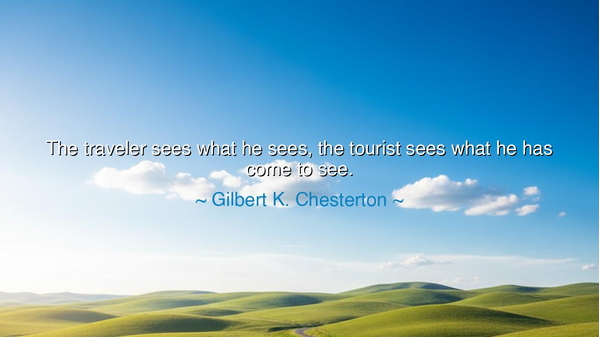
The traveler sees what he sees, the tourist sees what he has






Hear, O wayfarers of the earth, the words of Gilbert K. Chesterton, who declared with clarity: “The traveler sees what he sees, the tourist sees what he has come to see.” In this saying lies a distinction not of distance but of vision, not of miles walked but of hearts awakened. For there are those who move through the world seeking only to confirm their expectations, and there are those who move through the world with eyes unclouded, willing to behold what is, rather than what they imagined.
The ancients knew that perception is as great a journey as the road itself. To be a traveler is to be humble before the unknown, to let each moment reveal itself like a scroll slowly unrolled. But the tourist, as Chesterton warns, often arrives already burdened by pictures, maps, and stories. He looks not at the world, but at his own imagination reflected upon it. He does not see the city or the village as it is, but only as he has been told it must be. Thus, he does not truly encounter, but only consumes.
Consider the tale of Alexander von Humboldt, the great naturalist who wandered the Americas in the 19th century. He traveled not to confirm what Europe already believed, but to discover anew. He saw patterns in plants, climates, and peoples that others had overlooked because they came with rigid categories in their minds. In contrast, many colonial explorers looked only for gold or conquest—they were tourists of greed, blind to the true richness before them. Humboldt was a traveler, seeing what was, and thus reshaping how humanity understood the natural world.
The words also carry a warning against the arrogance of expectation. The tourist declares, “I will see the great cathedral, the famous square, the mountain that all admire.” And indeed, he sees them—but sees little else. He passes by the quiet street where children play, the humble inn where an old man sings, the unnoticed beauty that belongs only to those who pause. The traveler, however, does not dictate to the land what it must reveal. He receives it openly, and so discovers wonders that guidebooks never mention.
Chesterton’s wisdom also reveals something about the human soul. The way one approaches travel is the way one approaches life. The tourist soul moves through existence seeking only to affirm its assumptions, looking only for what it has already decided is valuable. The traveler soul remains open, curious, and humble—willing to be surprised, even corrected, by the world. The one lives in a cage of expectation, the other in the freedom of discovery.
The lesson is thus: when you walk through foreign lands—or even through the streets of your own town—walk as a traveler. Do not be bound by the images you carry in your mind. Let each sight, each sound, each face speak to you in its own language. For in doing so, you will not only see more of the world, but also more of yourself. The unfamiliar will not threaten you, but transform you.
Practically, this means slowing down. Put away the map for a moment. Wander without goal. Speak to those whom others pass by. Taste what is offered rather than what you already know. Practice presence instead of checklist. In this way, you train your spirit to be open, and every journey—whether across oceans or across a single street—becomes an adventure into truth.
So let these words endure: “The traveler sees what he sees, the tourist sees what he has come to see.” Choose to be a traveler in all things. For in openness lies wisdom, in humility lies beauty, and in discovery lies the fullness of life.






AAdministratorAdministrator
Welcome, honored guests. Please leave a comment, we will respond soon